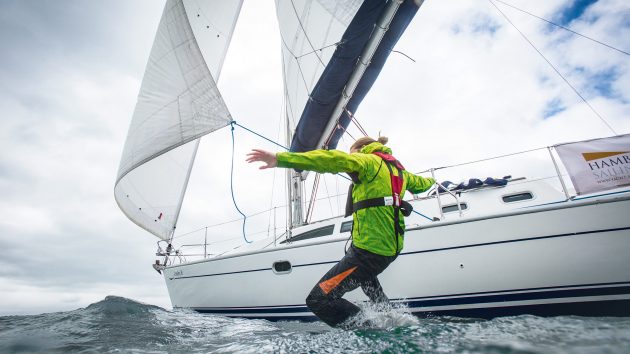James Stevens considers a problem sent in by a Yachting Monthly reader who asks how do you recover a man overboard
Paul and Emma own a 10m yacht and are day sailing with Paul’s parents on a fine day in early May. The weather is fair so they are all wearing fleeces and lifejackets but no wet weather gear is needed. The wind is about 10 to 15 knots coming off the land.
Paul’s father, Jack, was an enthusiastic sailor in his youth and is keen to get involved. He notices that the mainsail leech line is fouling the upper mainsheet block on the boom. Before Paul can do anything, Jack is standing on the cockpit combing, trying to free it. He loses his grip and falls in.
Fortunately his lifejacket inflates automatically. He shouts for help while Paul on the helm heaves to and Emma rolls up the jib. At that moment Jack stops shouting and waving. His body turns in the water as his feet act as a sea anchor and his face is now directly into the waves.
Paul realises the urgency of the situation, starts the engine, manoeuvres to a downwind position and motors carefully back positioning the boat on windward side of his father. Meanwhile Emma sends a Mayday call.
They arrive alongside Jack in the water.
Now what do they do?

With high topsides, getting a line onto the casualty can be extremely difficult
How do you recover a Man Overboard
There is a chance Jack is suffering from cold shock, a response to cold water that can cause cardiac arrest or a stroke. The problem has been compounded because as soon as the casualty becomes unconscious or too weak to paddle with their arms, the wind turns their body to face the waves.
Jack needs to be lifted out of the water as soon as possible. The first action is to release the main halyard to ensure the boat stops sailing and attach a line to his lifejacket. Ideally this can be done by holding him close with a boathook and leaning over the side.
If that’s not possible because the topsides are too high, either launch the liferaft or choose the riskier but quicker option of another crew member, attached to the boat, climbing down the ladder into the water.
Once a line is attached, hauling a casualty out of the water, even with a halyard winch, is remarkably difficult. A Handy Billy purchase, which can be attached to a halyard, or reversing the mainsheet blocks and using the boom as a crane will make the job easier.
It’s unnecessary to keep the casualty horizontal if they’ve only been immersed a short time. Three people knowing a life is at stake can apply a lot of muscle power. The chances of recovery are higher if the helm is a good boat handler, the crew have a plan for lifting a casualty and they can give first aid.
Enjoyed reading this?
A subscription to Yachting Monthly magazine costs around 40% less than the cover price.
Print and digital editions are available through Magazines Direct – where you can also find the latest deals.
YM is packed with information to help you get the most from your time on the water.
-
-
- Take your seamanship to the next level with tips, advice and skills from our experts
- Impartial in-depth reviews of the latest yachts and equipment
- Cruising guides to help you reach those dream destinations
-
Follow us on Facebook, Twitter and Instagram.





